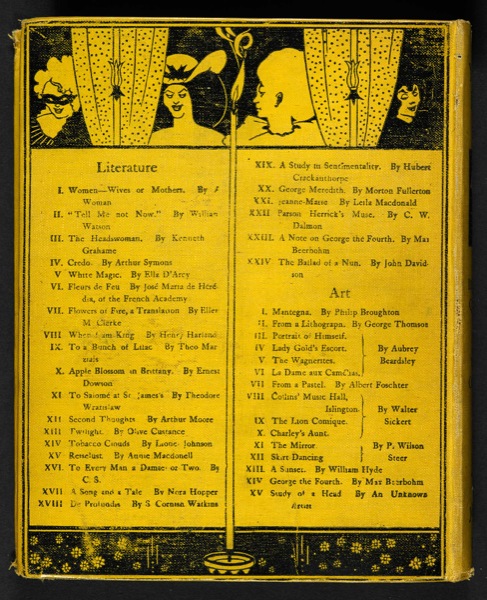【Never Sleep Alone (1984)】
The Never Sleep Alone (1984)Other Yellow Pages
Look
Pause Play Play Prev | Next 
Last week, the British Library launched Discovering Literature, an online collection of more than 1,200 items from the Romantic and Victorian periods, all of it meant to arouse interest in classic English lit. There are manuscript pages and juvenilia from Jane Austen, the Brontë sisters, Keats, Wordsworth, and Blake, among others, but the diligent forager will find Charles H. Bennett’s vivid illustrations for Aesop’s Fables; more than twenty-five drawings from Gustave Doré’s London: A Pilgrimage; nineteenth-century gynecological gaffes (“the majority of women [happily for them] are not very much troubled by sexual feeling of any kind”); and early vampire stories.
There’s also this: The Yellow Book. Not to be confused with the Yellow Pages or Redbook, The Yellow Bookwas an illustrated quarterly magazine with a provocative name; it came
from the notorious covering into which controversial French novels were placed at the time. It is, in fact, a “yellow book” which corrupts Dorian in Wilde’s original novel; this generally thought to be Joris-Karl Huysmans’ A Rebours(1884).
The founding principles were that literature and art should be treated independently and given equal status, and Aubrey Beardsley, illustrator of Wilde’s Salomé was appointed art editor.
Indeed, when Wilde was arrested in 1895, there were rumours he had been carrying a yellow-bound book. Though this was actually Pierre Louÿs’s French novel Aphrodite, a confused crowd thought it was a copy of this magazine, and gathered to throw stones at the publishers’ offices.
Those were the days, when the mere sight of a literary quarterly, or even something resembling a literary quarterly, could move a crowd to violence. The Yellow Book was published for only a few years, from 1894 to 1897, but it loomed large; nearly a century later, the scholar Linda Dowling called it “commercially the most ambitious and typographically the most important of the 1890s periodicals. [It] gave the fullest expression to the double resistance of graphic artists against literature, and Art against commerce, the double struggle symbolized by the paired words on the contents-pages of the Yellow Books: Letterpress and Pictures, Literature and Art.”
Search
Categories
Latest Posts
Parkland: Urgency and Insurgency
2025-06-25 22:03Grand Opera’s War with Itself
2025-06-25 21:24Seeing Reynolds Price Through His Art Collection
2025-06-25 21:10How the Unflappable Fred Astaire Survived the Fifties
2025-06-25 20:59Blood Will Out
2025-06-25 20:20Popular Posts
What a great week to be a woman in media!!
2025-06-25 22:06“Human Life Is Punishment,” and Other Pleasures of Studying Latin
2025-06-25 21:57Little Red and Big Bad, Part 5
2025-06-25 21:37Best eye massager deal: Save $50 on RENPHO Eye Massager
2025-06-25 20:56Featured Posts
Brand on the Run
2025-06-25 21:31The Ontology of Circus Peanuts by Jane Stern
2025-06-25 21:00Chekhov On: The Soul
2025-06-25 20:57Chekhov On: A Case of Mania Grandiosa
2025-06-25 20:17Hyperspeed of the Immediate
2025-06-25 19:49Popular Articles
#churchtoo
2025-06-25 22:17Announcing Our New Web Editor by The Paris Review
2025-06-25 22:09The Ontology of Circus Peanuts by Jane Stern
2025-06-25 21:36The Ashbery Files
2025-06-25 21:26The France of No Tomorrow
2025-06-25 21:01Newsletter
Subscribe to our newsletter for the latest updates.
Comments (8363)
Faith Information Network
Bankers’ Robberies
2025-06-25 21:48Exciting Information Network
John H. Johnson and the Black Magazine by Dick Gregory
2025-06-25 21:46Dream Information Network
Five Years Without Facebook
2025-06-25 21:30Upward Information Network
John H. Johnson and the Black Magazine by Dick Gregory
2025-06-25 21:03Evergreen Information Network
Spielberg’s Children
2025-06-25 20:29